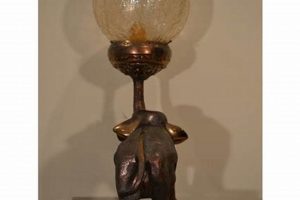Illuminating fixtures that combine the visual appeal of simulated rainfall with the warm glow of light, these decorative objects were particularly popular during the mid-20th century. Typically featuring a sculpture suspended within a framework of fine wires or filaments, a pump circulates oil through the wires, creating the illusion of falling rain. A light source within the base enhances the effect, producing a shimmering, captivating display.
Their appeal lies in the combination of kinetic art and ambient lighting. These fixtures served as statement pieces, adding a touch of glamour and novelty to domestic interiors and commercial spaces alike. The materials and designs reflect the aesthetic preferences of the era in which they were created, providing a glimpse into design trends and manufacturing capabilities of the past. They represent a tangible connection to a specific period in decorative arts history.
Subsequent sections will explore the history, design variations, maintenance considerations, and collector’s value associated with these distinctive lighting devices.
Guidance on Appreciating and Maintaining Vintage Oil Rain Lamps
The following offers practical guidance for prospective owners and enthusiasts to ensure the longevity and aesthetic quality of these unique light fixtures.
Tip 1: Verify Authenticity. Examine the lamp for manufacturer’s markings, material consistency, and construction techniques characteristic of the period. Discrepancies may indicate a reproduction or composite piece.
Tip 2: Assess Oil Quality. Clouded or discolored oil suggests contamination. Replace the oil with a refined paraffin oil specifically formulated for these lamps to ensure proper pump function and clarity.
Tip 3: Inspect Wiring and Electrical Components. Prior to operation, have a qualified electrician inspect the wiring, sockets, and plugs for damage or deterioration. Replace any faulty components to prevent electrical hazards.
Tip 4: Examine Suspension Filaments. Check the fine wires or filaments for signs of corrosion, breakage, or displacement. Repair or replace damaged filaments to maintain the desired rainfall effect.
Tip 5: Monitor Pump Functionality. Observe the oil flow pattern for consistency and uniformity. A weak or erratic flow may indicate a failing pump, requiring cleaning, repair, or replacement.
Tip 6: Implement Regular Cleaning. Periodically clean the lamp’s exterior surfaces with a soft, lint-free cloth to remove dust and residue. Avoid harsh chemicals or abrasive cleaners that could damage the finish.
Tip 7: Control Environmental Factors. Position the lamp away from direct sunlight and excessive humidity to prevent discoloration, corrosion, and other forms of degradation.
Adhering to these guidelines contributes to preserving the functionality and aesthetic value of these vintage items, ensuring their continued enjoyment.
The ensuing section will delve into the historical significance and cultural impact of these vintage lighting objects.
1. Design Aesthetics
Design aesthetics constitute a crucial aspect of assessing these vintage lighting fixtures, reflecting the artistic and stylistic preferences prevalent during their period of production. The visual appeal, materials used, and overall form contribute significantly to their collectibility and historical value.
- Sculptural Form and Motifs
The central sculpture, often depicting figures, flora, or abstract shapes, served as the focal point. These motifs reflect prevailing artistic trends, ranging from classical romanticism to space-age modernism. The chosen theme significantly influences the lamp’s overall aesthetic and desirability.
- Material Palette and Finishes
The selection of materials, including metals, plastics, and glass, reflects the manufacturing capabilities and stylistic preferences of the time. Finishes such as brass plating, chrome, and painted surfaces contribute to the lamp’s visual character. The condition and originality of these finishes are key factors in determining value.
- Illumination and Light Quality
The type of light source employedincandescent, fluorescent, or otherimpacted the overall ambiance and color rendition of the lamp. The design of the shade or diffuser, if present, further influenced the light quality, contributing to the lamp’s intended effect.
- Kinetic Element and Visual Movement
The simulated rainfall effect, achieved through the circulation of oil along filaments, provided a dynamic and visually captivating element. The density and pattern of the “raindrops,” as well as the smoothness of the oil flow, contribute significantly to the lamp’s aesthetic appeal.
These design elements, in combination, define the overall aesthetic character of these vintage lighting items. Understanding and appreciating these factors is essential for collectors and enthusiasts seeking to evaluate their historical and artistic merit.
2. Mechanical Functionality
The enduring appeal of these vintage fixtures is inextricably linked to their mechanical functionality. The reliable operation of the internal components directly influences the visual effect and overall lifespan. A failure in any part of the system can disrupt the rain-like simulation, diminishing the lamp’s aesthetic value. For instance, a worn-out pump, a common issue in aged models, can lead to inconsistent or nonexistent oil flow, negating the intended visual effect. Similarly, a clogged oil line can restrict circulation, causing the oil to drip unevenly or not at all.
The typical mechanical system includes an electric pump, a reservoir for the oil, a network of fine wires or filaments, and associated tubing to circulate the oil. The pump draws oil from the reservoir and pushes it upwards through the tubing to the top of the lamp. From there, the oil flows down the filaments, creating the illusion of rainfall. The design and efficiency of the pump, the gauge and material of the filaments, and the viscosity of the oil all play crucial roles in the effectiveness of the simulation. Proper maintenance, including regular cleaning and oil replacement, is vital for preserving the system’s functionality. The choice of replacement parts, when necessary, should align with the original specifications to ensure optimal performance and prevent damage to other components.
In essence, the mechanical functionality is the engine that drives the captivating display. Understanding its intricacies is paramount for owners and collectors who seek to maintain these vintage pieces in optimal working condition and to appreciate their intricate engineering. Addressing any mechanical issues promptly and correctly is crucial for preserving the lamp’s value and ensuring its continued operation.
3. Historical Context
The historical context surrounding vintage oil rain lamps provides crucial insight into their design, popularity, and cultural significance. Understanding the era in which these lamps were prevalent illuminates their role as more than mere lighting fixtures; they served as symbols of a specific period and its aesthetic values.
- Mid-Century Modern Design Movement
The peak popularity of these lamps coincided with the mid-century modern design movement (roughly 1945-1969). This movement emphasized clean lines, organic shapes, and innovative materials. The lamps’ often-abstract sculptures and incorporation of synthetic materials like plastics and Lucite directly reflect these design principles. Their presence in homes of the era signified an embrace of modern aesthetics and technological advancements.
- Post-War Consumer Culture
The post-World War II economic boom fueled a surge in consumerism. Families had more disposable income and were eager to acquire items that showcased their newfound prosperity. The novelty and visual appeal of the lamps made them highly desirable status symbols, signifying a modern and sophisticated lifestyle. Advertisements and popular media of the time frequently featured these lamps in aspirational settings.
- Technological Advancements in Manufacturing
The development of new plastics and improved manufacturing techniques enabled the mass production of the lamps at affordable prices. The use of injection molding and other processes allowed for intricate sculptural details and consistent quality. This mass production contributed to their widespread availability and popularity among middle-class consumers.
- Kitsch and Novelty Lighting
The lamps also align with a broader trend of kitsch and novelty lighting during the mid-20th century. Decorative items that offered a sense of whimsy and visual spectacle were highly sought after. The simulated rainfall effect, combined with the illuminated sculpture, created a unique and attention-grabbing display that resonated with consumers seeking to add personality to their homes.
In conclusion, understanding the historical context reveals these lamps as artifacts of a specific cultural moment. Their design, materials, and popularity reflect the convergence of mid-century modern aesthetics, post-war consumerism, technological advancements, and a broader appreciation for novelty and decorative lighting. Examining their historical background enriches the appreciation of their design and cultural significance.
4. Material Composition
The material composition of vintage oil rain lamps profoundly influences their aesthetic, durability, and historical value. The specific materials employed in their construction reflect the technological capabilities and design preferences of their era, contributing to their unique characteristics and collectibility.
- Metal Components
Metals such as brass, steel, and aluminum were frequently used for the lamp’s frame, base, and internal structural elements. Brass offered a decorative, warm-toned finish often protected by a lacquer coating, while steel provided structural integrity. Aluminum, being lightweight and corrosion-resistant, was used for certain components. The condition of these metal elementspresence of corrosion, pitting, or original finishsignificantly affects the lamp’s overall value and authenticity.
- Plastic Components
Plastics, particularly Lucite and other acrylics, were integral in creating the sculpted figures and decorative elements within the lamps. These materials allowed for intricate designs and translucency, enhancing the light diffusion and visual appeal. However, plastics are susceptible to yellowing, cracking, or discoloration over time due to UV exposure and age. The type and condition of the plastic components are critical factors in assessing the lamp’s aesthetic quality and historical accuracy.
- Wiring and Electrical Components
The wiring, sockets, and electrical components consisted of materials like copper, rubber, and Bakelite (an early plastic). The insulation of the wiring is prone to deterioration, posing a potential safety hazard. The presence of original Bakelite sockets and switches can indicate the lamp’s age and authenticity, but these components may also become brittle and require replacement. Safe operation necessitates careful inspection and potential replacement of deteriorated electrical elements.
- Oil and Suspension Filaments
The oil used for creating the rain effect was typically a refined paraffin oil with low viscosity and high clarity. The composition of the oil directly impacts its flow characteristics and longevity. Impurities or degradation of the oil can clog the pump and filaments, affecting the lamp’s operation. The suspension filaments, traditionally made of fine wire or nylon, are susceptible to breakage or corrosion. The material and condition of these elements are critical for maintaining the visual effect and mechanical functionality of the lamp.
In summary, the careful examination of the materials used in vintage oil rain lamps provides vital information about their history, design, and condition. Understanding the properties and degradation patterns of these materials is essential for collectors, restorers, and enthusiasts seeking to preserve and appreciate these iconic lighting fixtures.
5. Restoration Techniques
The application of appropriate restoration techniques is paramount to preserving the functionality, aesthetic value, and historical integrity of vintage oil rain lamps. Age, environmental factors, and mechanical wear contribute to the degradation of various lamp components, necessitating intervention to prevent further damage and to restore the fixture to its original condition. Improper restoration can irreversibly damage the lamp, diminishing its value and compromising its authenticity. For instance, aggressive cleaning methods can strip the original finish from metal parts, while the use of non-compatible replacement components can disrupt the lamp’s intended visual effect. Consequently, a thorough understanding of the lamp’s construction, materials, and period-appropriate techniques is essential.
Specific restoration procedures typically involve careful disassembly, cleaning, and repair or replacement of damaged parts. The pump, a critical component, often requires disassembly, cleaning, and lubrication to restore proper oil circulation. The fine wires or filaments, responsible for creating the rainfall effect, are prone to corrosion or breakage and may need to be meticulously repaired or replaced with historically accurate substitutes. Electrical components, particularly wiring and sockets, should be inspected and replaced if necessary to ensure safe operation. The original finish of metal parts should be preserved whenever possible; if refinishing is required, period-appropriate techniques and materials should be used to maintain the lamp’s aesthetic integrity. For plastic components exhibiting yellowing or cracking, specialized cleaning and repair methods may be employed, although complete restoration can be challenging due to the inherent degradation of these materials over time.
In conclusion, the proper restoration of vintage oil rain lamps requires a nuanced approach, balancing the desire to restore functionality and aesthetic appeal with the imperative to preserve historical authenticity. The application of appropriate techniques, careful selection of materials, and adherence to period-specific methods are crucial for ensuring that these unique lighting fixtures continue to function and be appreciated for generations to come. The long-term success of restoration efforts depends on a commitment to preserving the lamp’s original character and avoiding irreversible alterations that would diminish its historical value.
6. Collector Valuation
The collector valuation of vintage oil rain lamps is significantly influenced by several interdependent factors. Condition, rarity, design, manufacturer, and provenance exert considerable pressure on the perceived value and, ultimately, the transactional price in the collector’s market. A lamp in pristine, fully functional condition commands a substantially higher price than one with cosmetic flaws or mechanical issues. Rarity, dictated by production numbers and survival rates, elevates the value of specific models, particularly those from lesser-known manufacturers or featuring unique design elements. The design aesthetic, mirroring popular styles of the mid-20th century, can increase or decrease desirability based on current trends and preferences. Lamps produced by established manufacturers with a reputation for quality often realize higher valuations. Provenance, encompassing documented ownership history and significant historical associations, can substantially augment the lamp’s worth.
Practical examples illustrate the variability in collector valuation. A common model in fair condition might sell for a modest sum, primarily attracting buyers interested in the novelty of the item. Conversely, a rare example manufactured by a reputable company and restored to near-original condition can command a price in the thousands of dollars, appealing to serious collectors seeking investment-grade pieces. The practical significance of understanding these factors lies in the ability to accurately assess the value of a lamp, whether for purchase, sale, or insurance purposes. An informed approach to evaluating a lamps attributes allows both buyers and sellers to navigate the market with greater confidence and to make well-reasoned decisions.
In summary, the valuation of these vintage fixtures is a complex interplay of tangible and intangible factors. While condition and rarity are primary drivers, design, manufacturer, and provenance contribute significantly to the overall assessment. A thorough understanding of these elements is essential for anyone participating in the collector’s market, enabling informed decision-making and facilitating the appreciation of these distinctive lighting artifacts.
Frequently Asked Questions About Vintage Oil Rain Lamps
The following addresses common inquiries regarding the identification, maintenance, and valuation of these vintage lighting fixtures.
Question 1: How does one determine the age of a vintage oil rain lamp?
The age can often be estimated by examining the materials used in its construction. Early models frequently incorporated Bakelite or other early plastics, while later models utilized more modern materials. Design styles also provide clues, as certain aesthetics were more prevalent during specific periods. Consult resources on mid-century modern design for comparative analysis.
Question 2: What type of oil is recommended for optimal performance?
A refined paraffin oil with low viscosity is generally recommended. Specific formulations designed for rain lamps are available and should be considered. Avoid using vegetable-based oils or other lubricants, as they can cause clogging and damage to the pump.
Question 3: What are the primary indicators of a failing pump?
Inconsistent oil flow, diminished rainfall effect, or a complete cessation of operation typically indicate a failing pump. Unusual noises emanating from the base may also suggest pump malfunction. Professional repair or replacement may be necessary.
Question 4: How should the suspension filaments be cleaned?
Delicate cleaning with a soft brush or lint-free cloth is recommended. Avoid harsh chemicals or abrasive cleaners, as they can damage or corrode the filaments. Gently wiping the filaments with a cloth dampened with a mild detergent solution can remove accumulated dust or grime.
Question 5: What safety precautions should be observed when operating vintage electrical appliances?
Prior to operation, have a qualified electrician inspect the wiring, sockets, and plugs for damage or deterioration. Replace any faulty components to prevent electrical hazards. Ensure the lamp is properly grounded and avoid overloading electrical circuits.
Question 6: How does one assess the value of a vintage oil rain lamp for insurance purposes?
Consult with a qualified appraiser specializing in vintage lighting fixtures. Factors influencing value include condition, rarity, design, manufacturer, and provenance. Provide the appraiser with detailed photographs and any available documentation regarding the lamp’s history and characteristics.
Proper identification, maintenance, and adherence to safety precautions are essential for preserving and enjoying these vintage lighting artifacts.
Subsequent sections will address additional aspects of collecting vintage oil rain lamps.
Conclusion
This exploration of vintage oil rain lamps has revealed their multifaceted significance, extending beyond mere illumination. From their design aesthetics reflecting mid-century sensibilities to their intricate mechanical functionality, and from their material composition to the crucial techniques involved in their restoration, these artifacts offer a valuable lens through which to examine design history and consumer culture. Understanding the factors influencing their collector valuation is also essential for navigating the market and appreciating their lasting appeal.
The ongoing interest in vintage oil rain lamps underscores their enduring charm and cultural relevance. Continued research and informed stewardship will ensure the preservation of these unique lighting fixtures for future generations, allowing them to appreciate their historical value and artistic merit. Further investigation may also shed light on the design and manufacturing processes of the era, enriching our understanding of mid-century material culture.







